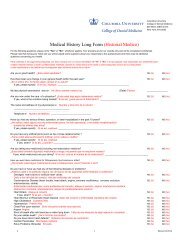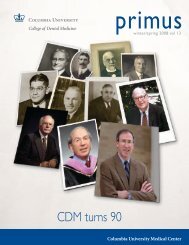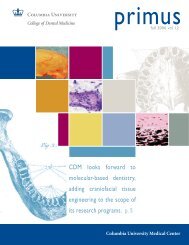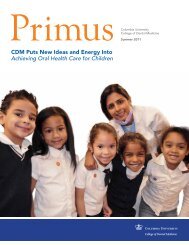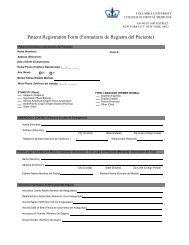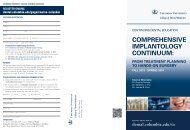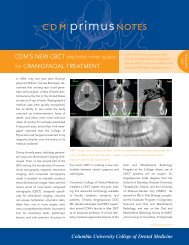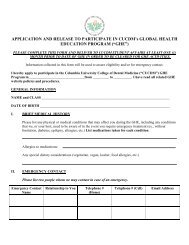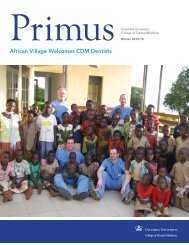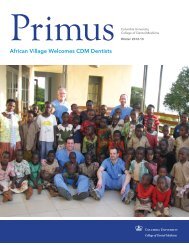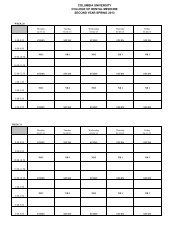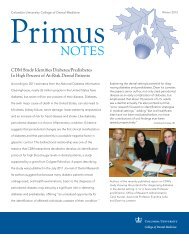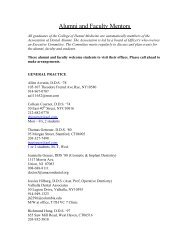Jarvie Journal - College of Dental Medicine - Columbia University
Jarvie Journal - College of Dental Medicine - Columbia University
Jarvie Journal - College of Dental Medicine - Columbia University
You also want an ePaper? Increase the reach of your titles
YUMPU automatically turns print PDFs into web optimized ePapers that Google loves.
Volume 56, Spring 2013<br />
Alveolar Bone Changes to Orthodontics in an Osteopenic Patient with<br />
Possible Hajdu-Cheney Syndrome<br />
Jeremy Zuniga 1 , Zachary Hirsch 2 , Ying Wan 2 , Sunil Wadhwa 3 *<br />
1<br />
Postgraduate Orthodontics Program, <strong>College</strong> <strong>of</strong> <strong>Dental</strong> <strong>Medicine</strong>, <strong>Columbia</strong> <strong>University</strong>, NY, NY<br />
2 <strong>Columbia</strong> <strong>University</strong>, <strong>College</strong> <strong>of</strong> <strong>Dental</strong> <strong>Medicine</strong> NY, NY; 3 Division <strong>of</strong> Orthodontics, <strong>College</strong> <strong>of</strong> <strong>Dental</strong> <strong>Medicine</strong>,<br />
<strong>Columbia</strong> <strong>University</strong>, NY, NY *Faculty Mentor<br />
Introduction: Hajdu-Cheney Syndrome (HCS) is a very rare autosomal dominant disorder <strong>of</strong><br />
bone metabolism characterized by progressive focal bone destruction, including acro-osteolysis<br />
<strong>of</strong> the distal phalanges and progressive osteoporosis. Only approximately 50 cases have been<br />
reported to date. The disorder is associated with a Notch2 mutation that is thought to be<br />
important in the development and maintenance <strong>of</strong> the skeleton by modulating RANKL-induced<br />
osteoclastogenesis. A 13-year old osteopenic male with skeletal Class III malocclusion and<br />
possible HCS presented for orthodontic treatment. The maxillary arch was severely crowded<br />
and the incisor angulation was extremely flared. In order to determine the extraction pattern <strong>of</strong><br />
the patient in the maxillary arch for pre-surgical orthodontics, we needed to determine how the<br />
patient would handle orthodontic tooth movement.<br />
Objective: To evaluate the alveolar bone effects <strong>of</strong> orthodontic tooth movement on an<br />
osteopenic patient with possible Hajdu-Cheney Syndrome using a cone-beam computed<br />
tomography (CBCT) and compare that to published norms <strong>of</strong> alveolar bone density and bone<br />
levels during orthodontic tooth movement.<br />
Materials and Methods: The first premolars were preferentially prescribed to expand 2.0 mm<br />
using clear plastic aligners, Invisalign (Align Technology). Cone-beam computed tomography<br />
(CBCT) images were taken prior to expansion (T 0 ) and 3 months following (T 1 ) the completion<br />
<strong>of</strong> expansion. Linear alveolar buccal bone levels were made by measuring for buccal bone<br />
thickness (BBT) and buccal marginal bone level (BMBL) at the right and left first premolar. In<br />
addition, bone density changes around the buccal aspects <strong>of</strong> the right and left first premolars at<br />
three portions <strong>of</strong> the root (cervical, intermediate, and apical) were calculated.<br />
Results: Actual expansion achieved immediately following expansion was 0.9 mm. Expansion<br />
remaining post-retention was measured at -0.01 mm. Linear CBCT measurements <strong>of</strong> the BBT<br />
from T 1 to T 2 revealed and a gain <strong>of</strong> 0.25 mm for the right premolar and a loss <strong>of</strong> 0.20 mm for<br />
the left premolar. The BMBL measurements revealed a gain <strong>of</strong> 0.66 mm and a loss <strong>of</strong> 0.07 mm<br />
for the right and left first premolars respectively. The bone density measurements increased<br />
during the study at 6% and 23% for the right and left first premolars respectively.<br />
Discussion: Out data indicates that, while 0.9mm <strong>of</strong> expansion was achieved initially, the<br />
patient was non-compliant in the retention phase <strong>of</strong> treatment. When the T 2 CBCT was taken,<br />
there was a slight constriction <strong>of</strong> the first premolars <strong>of</strong> 0.10 mm. In addition, the bone density<br />
around each premolar actually increased from T 1 to T 2 , which is the complete opposite <strong>of</strong> what<br />
happened in normal orthodontic tooth movement. Both BBT and BMBL were negligible in<br />
comparison to that <strong>of</strong> someone with normal bone physiology. Using a banded hyrax device<br />
would have eliminated the need for compliance during the retention phase <strong>of</strong> treatment.<br />
45



